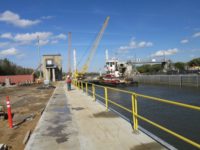

When he first met U.S. Army Corps of Engineers Col. Paul E. Owen, Roland Lewis was quite impressed. "He was, literally, a rocket scientist," says Lewis, president and CEO of the Metropolitan Waterfront Alliance.
That was in September 2012, and Owen had just taken up the post as Corps New York District commander.
A few weeks later, Superstorm Sandy wasted no time in giving Owen a less-than-warm welcome.
"Greatness," says Lewis, "was thrust upon him."
Owen, who holds master's degrees in aerospace engineering and nuclear engineering, suddenly found himself sloshing through water and learning about pumping out floodwater from tunnels.
"I had just been in Fort Bragg, jumping out of airplanes with the 82nd Airborne Division," he says wryly.
Until Sandy hit, Owen anticipated that his main focus would be on the ongoing harbor-deepening project, a study looking at flood risk reduction in the Passaic River Basin in New Jersey, and construction of the cadet barracks at West Point.
Working around the clock with New York City agencies, Owen's team helped "unwater" 500 million gallons of flooding in 13 days. Then, the long slog began. "It's more like a marathon than a sprint now," says Owen.
Owen's team now is immersed in 62 projects and studies, all at various stages, with an estimated
 |
| Owen |
Eight coastal storm risk-reduction projects, estimated at roughly $300 million, will place some 16 million cu yd of sand for engineered beach berms and dunes in New York City, Long Island and northern New Jersey.
Many resilience-related projects once sitting on the shelf are now on Owen's plate. He is overseeing 29 operations and maintenance projects, such as dredging channels impacted by Sandy or repairing navigational structures such as jetties and breakwaters. These efforts will cost, overall, an estimated $200 million.
"We have a unique opportunity to get stuff done," says Owen. "When I first got here, this was work we did not expect for a couple of years—projects that are authorized but were never built for whatever reason. Local opposition significantly decreased with the understanding of what Sandy can do. Now, people will see a level of sand and risk reduction they haven't seen since 1974."





